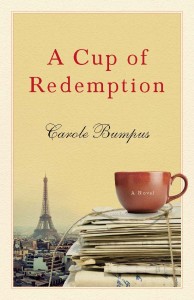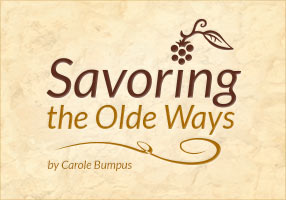 Sometimes inspiration comes when you least expect it. You may not understand its value at the time, but if you are lucky you plant the seed and curiously await the results. That happened to me a few years back, and planting those seeds has made all the difference.
Sometimes inspiration comes when you least expect it. You may not understand its value at the time, but if you are lucky you plant the seed and curiously await the results. That happened to me a few years back, and planting those seeds has made all the difference.
Before I decided to write my debut novel, A Cup of Redemption, I was busy writing short stories involving travel and food memoirs. While interviewing an elderly French woman, Marcelle, about her favorite French recipes—cuisine pauvre, or “French peasant food”—she stunned me when I asked, “What recipes did you prepare as a young wife?”
“Recipes?” she answered with a not unkind laugh. “We were in the middle of World War II and my husband was part of the French Résistance. It was often too dangerous for me to sneak into the field to get a potato or two for my family. We were in hiding. Recipes? Now, that was something I only dreamed of.”
My original idea of writing a regional French cookbook slipped by the wayside as my desire to understand this woman became pronounced. How had this woman, who struggled under the weight of war, managed her family? How had she, along with so many other valiant women and families, survived with war scrapping on their doorsteps? I’ve written about this moment before but, for me, this was defining moment and my first “seed” of inspiration.
On a second occasion—actually, on a food tour in southern Italy, I was resting on a large rock near an ancient sixth-century B.C. Greek temple in Paestum. With rapt attention I was listening to a retired professor giving a short talk—not about cucina povera (Italian peasant food), which was the reason I was touring—but about military history. He was waxing poetic about the battle which had taken place nearby in Salerno—not during Greek or Roman times, but during World War II. Waving his hand to the north and pointing beyond our view, he regaled us with the perilous happenings on those nearby beaches between the Allies and the Germans. With great detail as to strategy used, generals in charge, numbers of military involved, numbers killed and/or wounded, he explained the tragic outcome of that particular battle.
I nodded my head with interest, but waited until he completed his talk. Then I asked my question: “What about the people who lived here? How many were killed? How did families survive in the midst of this tragedy?”
He may have been dumbfounded by the naïveté of my question, but I, too, was left limp-jawed by his answer: “The military keep no records of unintended damage, injuries, or deaths caused by a military action, especially when it comes to unintended civilian casualties. It is known as ‘collateral damage.’ ”
I walked away from that conversation struck by the audacity of war and those who led it. I knew this gentleman was an expert in his field and he was only reporting on what was recorded, but I couldn’t get his words out of my mind: “It is known as ‘collateral damage.’ ” Not the people are considered collateral damage. I found the military’s total disregard of civilians—those vast numbers of men, women, children caught in the cross-hairs of war and never counted—was daunting. This was my second seed.
A year or so later, during a conversation with a young French woman, she mentioned her concern for her eighty-year-old grandmother from Bordeaux. The Twin Towers had come down, and so as the world was anxiously awaiting to learn if and when war would break out, her grandmother hit the reset button. Her experience of starvation in Paris during World War II was one she would never forget. And she was not taking any chances! She ordered a ton of potatoes to be delivered to her door. This was the third “seed,” for I began to realize how the impact of a war sixty years prior brought up memories along with a sense of immediacy and emergency for those who have lived with it . . . as did the following generations.
My novel, which focuses on three women—two French, one American, who separately experienced life-changing events during war—is about women’s struggles to rise up during and after the devastation of war. So, by the time I flew to France to follow up on Marcelle’s story, she had passed away and I was there to help her daughter unravel some of her mother’s mysteries. And it was there I was able to reap the fruits from the seeds of inspiration which had been planted.
Those three non-linear conversations—or seeds—propelled me forward for years—digging through archives, interviewing others, working with translators, reviewing transcriptions, plus reading, researching, and reading some more. (This is part of the writing process, I promise you. And, by the way, research is probably one of the most seductive things you can do, as you don’t want to stop.)
So, why did I take you on this lengthy description of my writing process? For me, my passion and drive to write this novel—which took twelve years, by the way—culminated with three offhand comments or three seeds of inspiration. You see, the seed of a story can find you anywhere or any time.

Leave a Reply